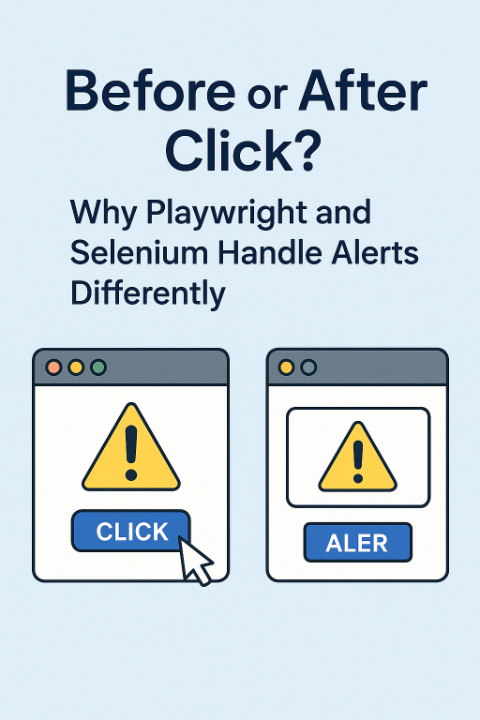 TESTING FRAMEWORK
TESTING FRAMEWORK Before or After Click? Why Playwright and Selenium Handle Alerts Differently

When testing web applications with Playwright or Selenium, you might notice something strange when a JavaScript alert pops up after clicking a submit button.
Key Difference:
In Playwright, you need to handle the alert before clicking the button.
In Selenium, you handle the alert after clicking the button.
✅Selenium – Handle Alert After Clicking
// Click the button that triggers the alert
driver.findElement(By.id("submit")).click();
// Switch to alert and accept it
driver.switchTo().alert().accept();
✅Playwright - Handle Alert Before Clicking
// Setting up alert handler BEFORE the click
page.onceDialog(dialog -> dialog.accept());
// Now click the button that triggers the alert
page.click("#submit");
To understand why alert handling works differently, we need to look under the hood — at how Selenium and Playwright talk to the browser.
🧰 Selenium: WebDriver Protocol (Remote Control)
Selenium uses the WebDriver protocol, which sends commands (like clicks or alert handling) to the browser through a remote server.
Here's what happens:
- You write test code.
- Selenium sends that command (e.g. click()) to the browser through WebDriver.
- The browser processes it and returns a response.
- Selenium waits for changes — like waiting for an alert to appear.
🎯 Selenium is like a remote control for your browser.
It clicks, waits, checks — all step-by-step.
✅ That’s why it can handle alerts after the click — it polls for the alert and handles it when it becomes visible.
⚙️ Playwright: DevTools Protocol (Native, Event-Based)
Playwright uses the Chrome DevTools Protocol (CDP) (or equivalents for other browsers). This gives it low-level, event-based access to the browser.
Here’s how it works:
- You tell Playwright to watch for an alert.
- Playwright connects directly to the browser’s internal events.
- When the alert shows up, Playwright catches it — but only if it was already watching.
- Then you click the button that causes the alert.
🎯 Playwright is like being inside the browser’s brain.
It sees events as they happen, not after.
❌ If you're not listening before the alert shows up, Playwright misses it — and your test fails.
Why This Matters for Alert Handling
- Selenium is reactive. It can click, then wait and switch to an alert after it's visible.
- Playwright is proactive. It expects you to set up listeners ahead of time for anything asynchronous, like alerts, downloads, or popups.
So, the difference in alert-handling timing isn't random — it's rooted in how each tool connects to the browser itself.
✅ Final Takeaways
- Use Selenium for more traditional, synchronous step-by-step testing — it’s more forgiving with timing.
- Use Playwright for faster, more event-driven testing — but you must prepare for events before triggering them.